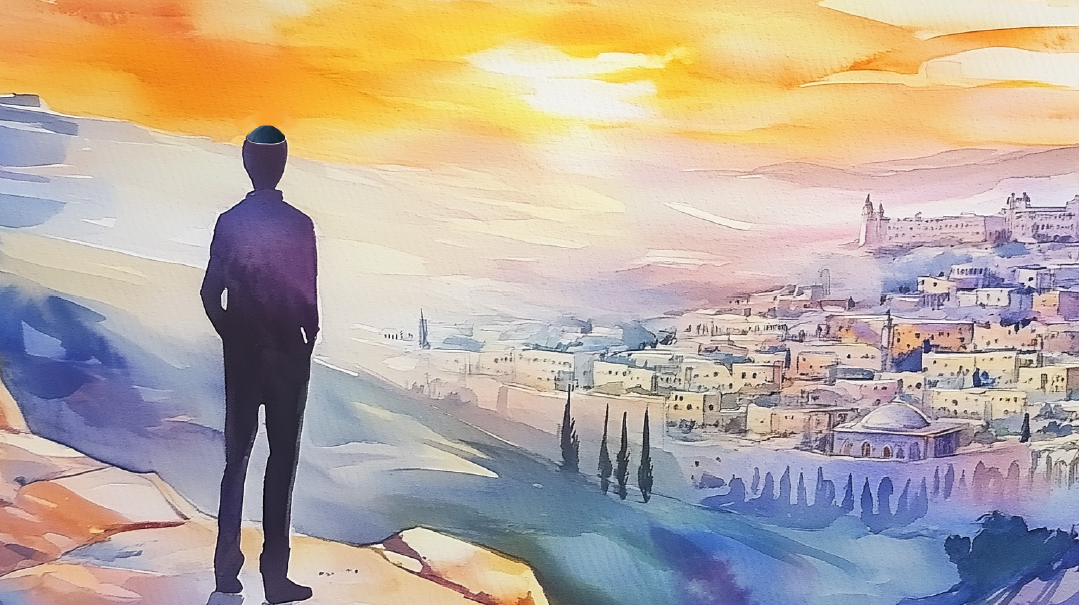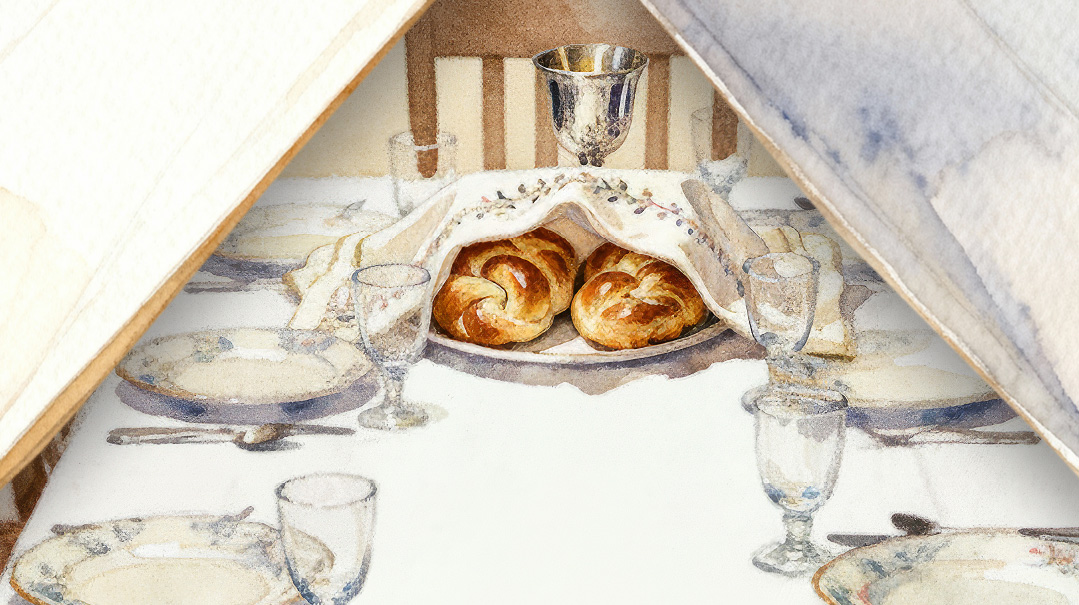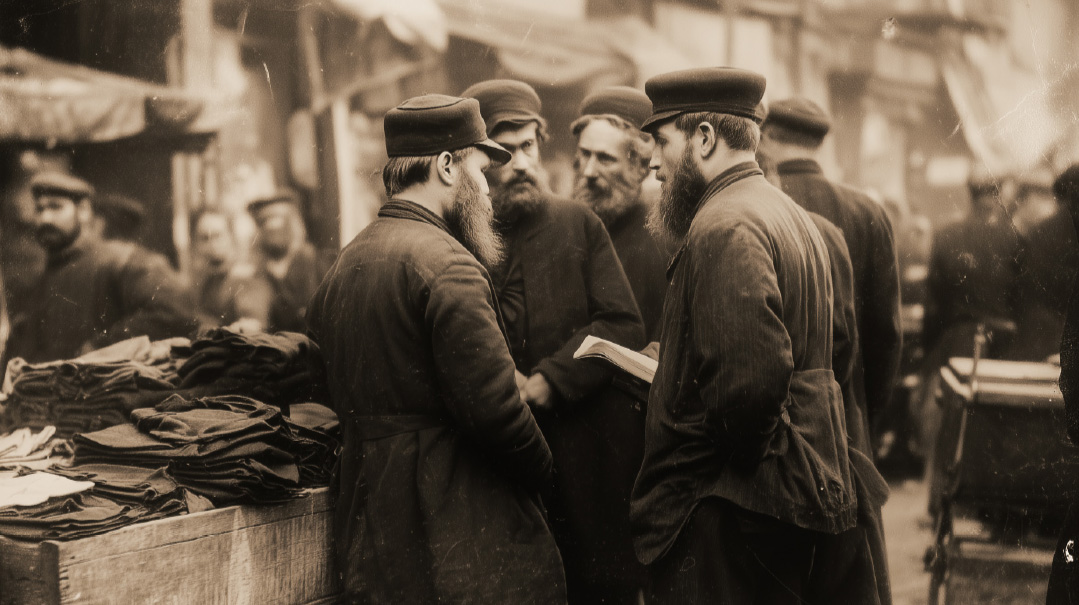The Greatest Gift
| April 1, 2025Why, wondered Rabbi Yishai Kalfa, were there no English seforim highlighting the chashivus of Eretz Yisrael?

One thing that Rabbi Yishai Kalfa, a talmid chacham who’s lived more than half his life in the Holy Land, couldn’t understand was the dearth of English-language works on the centrality of Eretz Yisrael. And so, he wrote one himself.
Rekindling a Forgotten Love
Every time Rabbi Yishai Kalfa walked into a seforim store catering to the yeshivah community, he found himself pondering the same question.
A kollel avreich who has been living in the Holy Land for more than half his life, Rabbi Kalfa’s love for Eretz Yisrael was as much a part of his existence as the oxygen he breathes. So why, wondered Rabbi Kalfa, were there no English seforim highlighting the chashivus of Eretz Yisrael?
“You can find ten English books on tefillah, fifteen on emunah, eight on Shabbos, and another six on shemiras halashon, but there is almost nothing for the mainstream chareidi community on the mitzvah of living in Eretz Yisrael,” says Rabbi Kalfa.
With mentions of Eretz Yisrael far outpacing those of any other mitzvah in the Torah, the omission was troubling to Rabbi Kalfa, who spends his days learning at Jerusalem’s Yeshivah Yechaveh Daat, a well-known Sephardi halachah kollel, where he also serves on the beis hora’ah.
“You have to be blind not to notice that the topic of Eretz Yisrael has become a taboo subject for us,” notes Rabbi Kalfa. “You can’t speak about it unless it is in relation to finding a good seminary or a good yeshivah.”
Having been entranced by the dozens of stories he had about gedolim with a tremendous chavivus for Eretz Yisrael, Rabbi Kalfa started thinking of compiling a volume that would include a short daily devar Torah sourced from Tanach emphasizing the importance of Eretz Yisrael. Each one would be paired with a story about a prominent chareidi rav echoing a similar theme.
The result was The Gift of Eretz Yisrael, which, as its cover proclaims, is intended “to rekindle a forgotten love” for the Holy Land. The book bears the haskamos of Rav Shmuel Kamenetsky and Rav Reuven Feinstein, and includes a forward by Rabbi Zev Leff. Rabbi Kalfa is quick to note that while technically, he may have authored the sefer, its chiddushim are those of revered gedolim, including the Chofetz Chaim, the Ben Ish Chai, the Chasam Sofer, Rav Yisrael of Ruzhin, Rav Eliyahu Eliezer Dessler, the Alter of Slabodka, Rav Shraga Feivel Mendlowitz, Rav Yosef Shalom Kahaneman, and Rav Mordechai Shlomo Friedman of Boyan, to name just a few.
Rabbi Kalfa eagerly shares a story that occurred after Rav Mordechai Gifter left Cleveland to build a yeshivah community in Telz Stone. According to Rabbi Kalfa, Rav Gifter described those years as the happiest in his life, and he reveled in the opportunity to give longer and more frequent shiurim than he had in Cleveland. Rabbi Gifter’s life took a drastic turn when the rosh yeshivah in Telshe Cleveland, Rav Boruch Sorotzkin, was niftar, with the Steipler Gaon directing him to return to Ohio and become the new rosh yeshivah.
“He felt like he was being cut off from his life source,” explains Rabbi Kalfa. “He went back to Cleveland, but he was so sad about not living in Eretz Yisrael that he made a bold decision, one that his wife agreed to go along with. Explaining that he couldn’t live in a house in chutz l’Aretz, Rav Gifter and his wife lived in the dorm in Telshe.”
Other stories that Rabbi Kalfa recounts in The Gift of Eretz Yisrael detail the Chofetz Chaim’s deep passion for the Holy Land. In addition to including a stipulation in the tena’im written for each of his three daughters removing his obligation to support the couples, should he move to Eretz Yisrael, the Chofetz Chaim included mention of a possible move to Eretz Yisrael in the tena’im written for his second marriage. Rabbi Kalfa has found that most people are surprised to learn that the Chofetz Chaim tried to relocate to Eretz Yisrael on four different occasions.
“The average person might know that the Chofetz Chaim loved Eretz Yisrael, but they don’t realize that he was so convinced that he was going, he sent his belongings ahead and his followers had already bought him a house in Petach Tikvah,” says Rabbi Kalfa.
Born and bred in Toronto, Rabbi Kalfa’s connection to Eretz Yisrael runs deep. When his family started making plans for a midyear move to the Holy Land, then 15-year-old Yishai chose to go to Israel alone at the start of the school term. He spent the next five years learning in the Old City at Yeshivah Porat Yosef before getting married and moving to Yeshivah Yechaveh Daat nine years ago.
While coming up with the divrei Torah for his book was relatively simple, locating the accompanying stories was far more time-consuming. Because most books on gedolim published for the yeshivah audience don’t place much emphasis on Eretz Yisrael, Rabbi Kalfa estimates that he spent hundreds of hours looking for stories for his sefer.
In one instance, Rabbi Kalfa managed to connect with the gabbai of Rav Shlomo Zalman Auerbach, resulting in an eight-hour-long interview. Rabbi Kalfa was elated to find himself face-to-face with two full shelves of Rav Shlomo Zalman’s handwritten notes, which ranged from halachic discourses to reminders to call the electric company.
“I had to type it all out and then repeat it to the gabbai word for word to make sure that everything I had was accurate,” says Rabbi Kalfa. “It was material that isn’t quoted anywhere else, and it made it clear that Eretz Yisrael wasn’t just something to Rav Shlomo Zalman — it was everything.”
One of those stories discussed Rav Shlomo Zalman’s son’s engagement to a girl from London. After Rav Shlomo Zalman expressed his agreement to having the wedding in London multiple times, the mechutan eventually learned that Rav Shlomo Zalman had never set foot outside Israel. Asked why he had agreed to a European wedding, Rav Shlomo Zalman explained that his wife and children would travel to London for the simchah, while he celebrated from afar.
“Nothing more needed to be said,” says Rabbi Kalfa. “The wedding was moved to Yerushalayim. How sad it is that these stories aren’t published anywhere!”
Now in its second printing, The Gift of Eretz Yisrael also includes 36 pages of responsa from Rav Chaim Kanievsky on Eretz Yisrael-related matters. Despite the many hours and significant costs involved, a follow-up volume is already in the works, with Rabbi Kalfa intent on getting readers fired up about their true homeland.
Asked to name his favorite place in Eretz Yisrael, Rabbi Kalfa doesn’t hesitate, sharing that while he feels very connected to the Kosel and the Old City, Gush Etzion and the Shomron hold a special place in his heart.
“Whenever I have three days off, I go there,” muses Rabbi Kalfa. “I sit under a tree and I feel Tanach coming to me. It just does something to me.”
Rabbi Kalfa supplied his five favorite stories from the book, excerpted here.
Precious Gifts
Stories Excerpted From Book
The Ben Ish Chai knew that his stay in Eretz Yisrael would eventually come to an end and he would soon have to return to Iraq to continue leading his beloved community there. Still, he couldn’t bring himself to simply leave the Holy Land without bringing something back with him as a souvenir. He also knew that bringing back a part of Eretz Yisrael would ingrain in the hearts of his community back home a great love and passion for the Land. Therefore, before taking leave of the Holy Land, the Ben Ish Chai collected a bagful of soil from Eretz Yisrael, a stone from next to the Kosel Hamaaravi and a stone from Har Hazeisim and brought them back with him to Iraq.
Upon his arrival back in Baghdad, the Ben Ish Chai took the soil that he had brought along with him from Eretz Yisrael and spread it all over the floor of the ancient synagogue in Baghdad. The stone from the Kosel Hamaaravi was placed under the mezuzah affixed to the doorpost of the synagogue, and whenever a person entered the synagogue, he would kiss both the mezuzah and the stone. What about the second stone, taken from Har Hazeisim? The Ben Ish Chai hired a talented craftsman to etch a picture of the Kosel surrounded by cypress trees onto the stone. He kept the stone for himself, telling family members that he wanted the stone to be placed next to him in his grave after his death.
*
Rav Yosef Chaim Sonnenfeld’s fierce desire to settle in Eretz Yisrael can be demonstrated by the following story. His neighbor and student, Rav Yisrael Yaakov Bernstein, once mentioned that the rav of Jaffa, Rav Naftali Hertz, had declared, upon announcing his decision to move to Eretz Yisrael, that even if he were forced to go from door to door and beg people for food, he would still not hesitate to carry out his plan.
Upon hearing this anecdote, Rav Sonnenfeld smiled and replied, “I don’t find anything particularly incredible about that. I suffered an even poorer fate.”
He was referring to the untimely passing of eight of his eleven children.
Aside from the deaths of his children, though, Rav Sonnenfeld made many other sacrifices. He was well aware, even before setting sail to the Holy Land, of the poverty that was rampant there. Yet he willingly gave up the remaining eight years of financial support promised by his father-in-law in order to come to the Holy Land.
Later on in life, Rav Sonnenfeld would reminisce about what had happened when word got out that he intended to emigrate. A wealthy Jew from Pressburg approached him and offered to support him financially for the rest of his life provided that he would remain in the Diaspora. Rav Sonnenfeld declined this offer as well, unwilling to alter his lofty aspirations.
*
The son of the Maharil Diskin, Rav Yitzchak Yerucham Diskin, forged a special bond with one of Rav Yosef Chaim Sonnenfeld’s grandchildren. This grandson was an exceptional talmid chacham, and Rav Diskin would give him copies of the dissertations that he delivered in the presence of the leading Torah scholars of Yerushalayim.
Upon Rav Sonnenfeld’s grandson’s marriage, Rav Diskin tried to persuade him to seek a rabbinical position in Europe. Such a position, he felt, would ensure financial stability for the budding talmid chacham, who would then be able to continue immersing himself in Torah study. Rav Diskin pleaded with his father, the Maharil, to find the young man a position, explaining that many big talmidei chachamim living in Eretz Yisrael had failed to reach their true potential due to the difficulty of earning a livelihood. The Maharil fulfilled his son’s request and secured for Rav Yosef Chaim’s grandson a position as rav for a community in Czechoslovakia.
The grandson went to seek direction from his saintly grandfather, Rav Sonnenfeld. He described his financial plight and expressed his great desire to continue his Torah studies. Then he told his grandfather about the position awaiting him in Czechoslovakia, which he felt was the only way he might achieve his goals.
Rav Sonnenfeld gave his response with love and candor. “My dear son,” he said, “in my opinion, it is better to be a simple laborer in Eretz Yisrael than a rav in chutz l’Aretz.”
After hearing these profound words, his grandson immediately abandoned his plans.
*
Involvement in various organizations was not the only way that Rav Moshe Mordechai Epstein’s love and passion for Eretz Yisrael manifested itself. Shortly after assuming the leading role in Ness Tziona while studying under the Netziv in the Volozhin yeshivah, Rav Epstein traveled to Eretz Yisrael as part of a small group of people. Their goal was to purchase land from the Arabs. Shortly after this trip, Rav Epstein made a second trip to the Holy Land in order to acquire an even larger portion of land. His efforts were successful and the group managed to purchase a plot of land close to the Shomron area, large enough to house thousands of Jews. Today, the city of Hadera sits on this plot of land.
Incredibly, to this very day, the Hadera municipality displays the photo of the pioneers who redeemed the land that Hadera was built on from the Arabs. The photo shows a group of handsome, European-looking young men. These men were actually all single students from Yeshivas Volozhin, and seated in the center of that picture is none other than Rav Moshe Mordechai Epstein.
*
Reb Hershele of Teveria, who was a grandson of the Baal Shem Tov, once came to visit the holy Ruzhiner. The holy Ruzhiner commenced the meeting by interrogating his guest about the minutest details of what was taking place in the Holy Land. The Rebbe was unprepared to forgo even the smallest bit of news until finally, his guest, Reb Hershele, told him about a quarrel in a certain shul between two tailors.
“Alas,” the Rebbe responded, “this is exactly what I was searching for. The reason for my concern is that a quarrel in the Holy Land, even between two simple people, creates greater tumult in Heaven than a quarrel between two very great people in chutz l’Aretz.”
*
When the Ruzhiner’s wife, Sarah, passed away on the last day of Pesach in the year 5607/1847, the holy Rebbe wept inconsolably. Sometime later, when his chassidim asked for an explanation, he said, “After the Baal Shem Tov’s wife passed away, he embarked on a journey to ascend to Eretz Yisrael, but a violent storm stopped him. Clearly, Hashem did not want him to go. When the Baal Shem Tov pressed on, reaching as far as Constantinople, he saw Heavenly signs showing him that he should return. The Baal Shem Tov explained that since his wife had been laid to rest in chutz l’Aretz, Hashem decreed that he must remain in chutz l’Aretz with her.
“I, too,” continued the holy Ruzhiner, “have always dreamed of ascending to Eretz Yisrael. Now that my wife has been buried here, I am afraid that Hashem has decreed that I too must remain here. For that, I cry.”
(Originally featured in Mishpacha, Issue 1056)
Oops! We could not locate your form.







